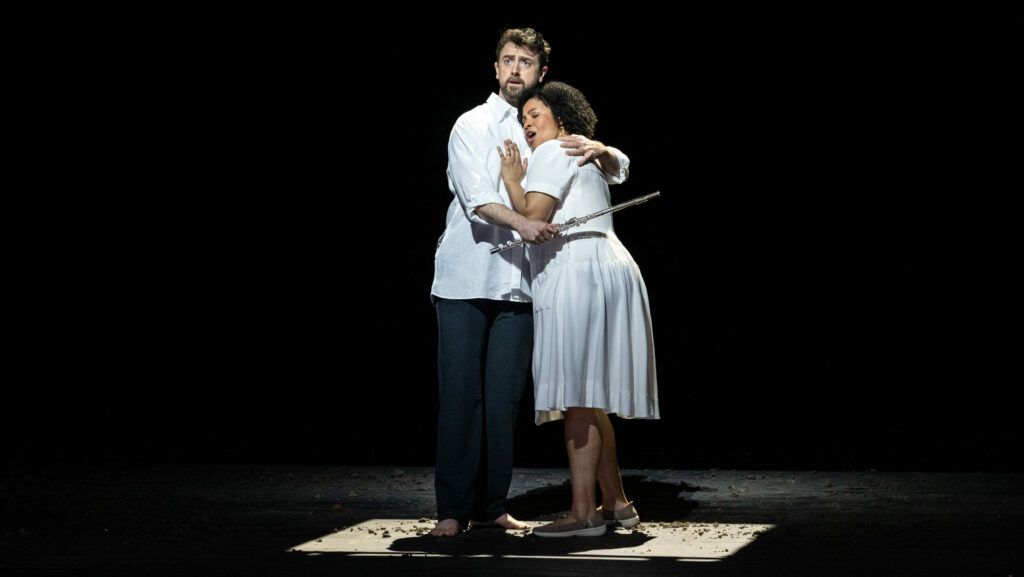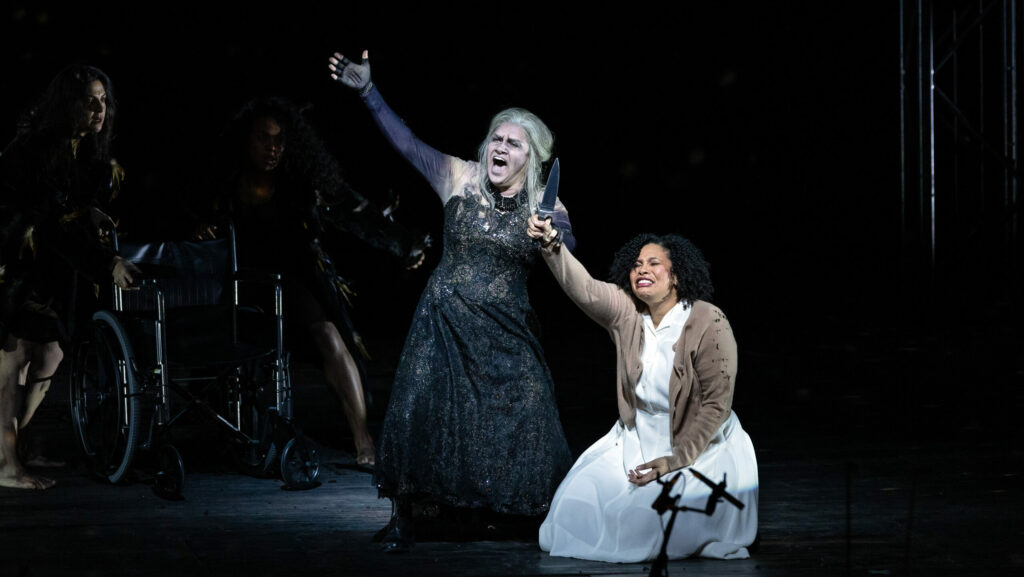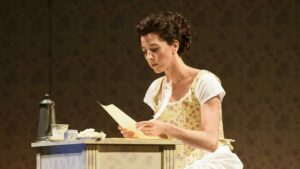
Marty Sohl
The libretto, by the composer’s Masonic brother Emanuel Schikaneder, has everything to give a director fits or turn an audience’s stomach: orientalism, misogyny, blackface, torture, children, animals, a dragon, a flying machine, continuity errors, and of course, in Papageno, a big, juicy comic role for Emanuel Schikaneder.
You already know the story. Rescued from a serpent by the minions of the Queen of the Night, who arm them with the titular flute and set of magic bells, a Japanese prince (Tamino) and a dimwitted but lovable bird-catcher (Papageno) undertake to rescue her daughter (Pamina) from Sarastro’s Egyptian priesthood, but Sarastro turns out to be a pretty decent guy who initiates the heroes into his temple, lets Pamina marry Tamino, and even hooks Papageno up with a Papagena. Everything you need for a big, dumb 18th-century stage spectacle, in other words, but nothing that rises to one of Mozart’s brilliant and compelling scores, and certainly nothing resembling a sophisticated theater piece for us snooty, jaded 21st-century operagoers.
Fortunately, director Simon McBurney, whose production returned to the Met on Sunday, likes a challenge. If you didn’t catch it in one of its earlier runs, either here at the Met or across the pond, you may remember McBurney as Herr Knock, the Renfield character in last year’s big-screen Nosferatu remake (note to self: watch last year’s big-screen Nosferatu remake), but if you did see his Magic Flute, you know that he rose to the occasion by stripping away the story’s fairy-tale trappings and leaning into the artifice of the stage effects.

Contemporary opera stagings lean heavily on video projections, with varying degrees of success, and this one goes into the Win column. The key is that the projections have to mean something, they have to do something, instead of supplying a cheap and convenient backdrop, because honey, if you’re just gonna press play on a video for us, we might as well have saved a few bucks and watched that shit at home. Here, much of the visual and sound design is produced live: an artist at one side of the stage amplifies thunder sheets and clinking bottles, while on the other side another artist trains a camera on shadow puppets and miniature “sets,” giving us a bit of unexpected magic right from the start and, frankly, handling the opera’s themes more deftly than the libretto does.
Light and darkness, order and chaos, fire and water, man and woman, white and black, truth and deception: among other things, this is a piece about dualities, culminating in the union of its two young lovers. But as W.H. Auden and Chester Kallman noted, it doesn’t actually do a great job of navigating those dualities, falling instead into a Jordan Petersonesque hierarchy of one over the other. It doesn’t make sense! The Masculine can’t defeat the Feminine (without which it has no meaning); Day can’t triumph over Night (because then EVERY opera would be a matinée). McBurney’s production, like Auden & Kallman’s adaptation of the libretto, makes more of an attempt to find compromise or synthesis between extremes, starting with that harmonious balance of visual and sound effects.
Now seeing this production for a second time, I kept noticing more details along these lines. The white hardbacks that become Sarastro’s temple line the visual artist’s station, turning it into a little Apollonian library, while the foley artist’s battery is lined with the bottles that will tempt the Dionysian Papageno. Even the left and right hands of the visual artist seem to alternate between feuding (tussling over the chalkboard where he’s drawing the projections) or collaborating harmoniously (crossing his T’s and dotting his Ü’s with quasi-ambidextrous calligraphic choreography).
Elsewhere, the production blurs the lines that bound conventional opera stagings. No curtain divides the stage from the auditorium; the house lights only fade from light to darkness after the Overture has already begun. Papageno’s clowning not only breaks the fourth wall, it sends him climbing down a flight of convenient stairs into the audience to look for a date; he not only plays his little magic bells, he gets into a whole comic back-and-forth with the keyboardist in the elevated orchestra pit; etc.

Marty Sohl
In terms of the actual drama, the blurring of boundaries plays out by leaning into a bit of the opera’s creepiness around Sarastro and his cult. Costume designer Nicky Gillibrand has dressed these sun worshipers in somber gray and black business suits around a grim conference table, and the only illumination they seem to receive (in designer Jean Kalman‘s lighting scheme) is from a bank of cold, harsh fluorescent bulbs. At the moment when Sarastro reveals to Pamina that he knows of her mother’s plot to kill him and undermine his temple, a line jumped out that, as far as I can tell, is original to McBurney’s production: Dieses Geschöpf der Finsternis, ich erkenne es auch in mir (“This presence of darkness, I recognize it also in myself”). The unnatural light of his temple only takes on the warmth of the sun in the opera’s finale, when the lovers unite to form a symbolic sun—and the director brings his and the Queen’s forces together onstage in a balance of yin and yang.
Their vocal forces, however, were not quite as well-matched. Vocally and dramatically, Kathryn Lewek is an ideal Queen of the Night—her first aria throbbed with emotion, especially in her clear, haunting pianissimi, and her thrilling, terrifying traversal of the (okay, I’ll say it) iconic second aria sent wave after wave of chills across my body. I love when a Queen takes just a little time on those stratospheric coloratura passages, shaping each note, and Lewek in no way disappointed.
The player on the other side, Stephen Milling, brought an actorly gravitas and sensitive musicianship to the role of Sarastro, and a warm, oaky sound to his baritone register. But just as the Queen of the Night flaunts her range in the ledger lines above the treble staff, Sarastro’s show-off notes lie at the bottom of the bass, where Milling simply didn’t have the oomph.
Tamino and Pamina are reliably the blandest characters in the piece, but they also have the prettiest arias. Tenor Ben Bliss brought a big, radiant tone and fine legato phrasing to the all of Prince’s highly exposed numbers, but I quibbled in the first Act that the light, (appropriately) fluting tone of Golda Schultz, whose Mozart has always thrilled me in the past, wasn’t settling into her uptempo lines the way I wanted it to. She more than won me over in the second half of the piece, however, which makes me wonder if the problem lay with conductor Evan Rogister. The last time we saw this production, it was with the assured hand of Nathalie Stutzmann at the helm, bringing clarity and lyricism to the score; this time, with Rogister leading the show at the requisite screwball pace, a few moving parts skittered out of his grasp.

Thomas Oliemans, returning to the role of Papageno, once again proved he had the vocal and comic chops for the role, though the shtick was a little less amusing the second time around—and was it really necessary for both his character and Thomas Ebenstein‘s Monostatos to whip their dicks out onstage? (Errm, to be clear, you don’t actually see hog. It was just implied, as part of their comic business, that at one Papageno was taking a leak, and at another, Monostatos was caught whacking off to a sleeping Pamina, with their respective backs to the audience.) That said, Monostatos as corporate toady works a hell of a lot better than as a racist stereotype, and Ebenstein gave a solid vocal performance while giving full-on comic creep. And maybe there’s something going on here about balancing the opera’s two slaves to appetite: Papageno, the innocent child of nature, vs. Monostatos, the perv who really ought to know better…?
At any rate, the production remains a triumph of theatrical ingenuity, and while I’m sure Michael Levine‘s pared-down unit set and Gillibrand’s low-key costuming will disappoint some in the audience, it’s nice to know we don’t have to see Julie Taymor‘s eye-wateringly ugly costumes unless we go to see the Met’s English-language kids’ performances. More to the point, the designs represent the blurring of another boundary: that between the fantasy realm of the Flute and our modern world. This stark staging remains surprisingly welcoming to the contemporary viewer—just ask the audience member who had to be redirected by ushers, minutes before Sunday’s performance, when he briefly attempted to cross to the other side of the auditorium via the steps leading up to the stage—and conversely, by turning ordinary objects and people into the stuff of fairy tales, it lets a little bit of magic seep out into the everyday.





Comments